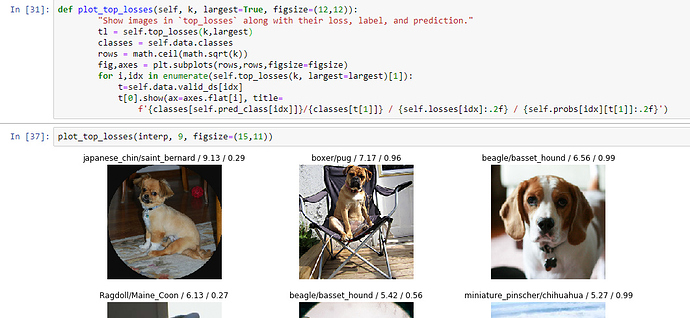I just read the source code, inside the function, it automatically takes the start and stop to form a geometric series.
please take this to Fastai v1 install issues thread after you read/applied:
https://docs-dev.fast.ai/troubleshoot.html#correctly-configured-nvidia-drivers
basically you have an issue with pytorch, not fastai.
In the notebook you can doc or ??learn.lr_range.
From the code it slice with learn.layer_groups, which is 3 for the whole resnet34.
According to source code, the last number is the probability of the predicted class, not the actual class. I guess it should be fixed in the documentation.
self.probs = y_pred.sigmoid() if sigmoid else y_pred
…
f'{classes[self.pred_class[idx]]}/{classes[t[1]]} / {self.losses[idx]:.2f} / {self.probs[idx][t[1]]:.2f}')
I’m reading the documentation right now and I don’t think that’s the case probs[idx][t[1]] is the actual class (t[0] is the image, and t[1] is the label)
Yes but the 1 is not for the predicted class but for the actual class (if softmax is used that number should be quite low)
So here is the source code:
def plot_top_losses(self, k, largest=True, figsize=(12,12)):
"Show images in `top_losses` along with their loss, label, and prediction."
tl = self.top_losses(k,largest)
classes = self.data.classes
rows = math.ceil(math.sqrt(k))
fig,axes = plt.subplots(rows,rows,figsize=figsize)
for i,idx in enumerate(self.top_losses(k, largest=largest)[1]):
t=self.data.valid_ds[idx]
t[0].show(ax=axes.flat[i], title=
f'{classes[self.pred_class[idx]]}/{classes[t[1]]} / {self.losses[idx]:.2f} / {self.probs[idx][t[1]]:.2f}')
The first thing I do with this is look at what is generating this. So I ran the notebook up to the point where it runs the interp.plot_top_losses and I copy and pasted that code into the notebook so I could mess around with it.
So this is what that looks like for me:
You’ll notice I had to feed interp to it instead of doing interp. (there is probably a way to change that, but this works)
So now, I start looking at the individual lines so the first line for me now looks like this:
interp.top_losses(9,True)
So basically that is taking the 9 largest losses and it looks like you could pretty easily take the smallest losses by changing that to false.
Onto the actual answer to your initial question:
Here are the four things:
f'{classes[self.pred_class[idx]]}/{classes[t[1]]} / {self.losses[idx]:.2f} / {self.probs[idx][t[1]]:.2f}'
The first is the prediction of each image: classes[self.pred_class[idx]]
The second is the true value: classes[t[1]] (t is pulled earlier and has the image in t[0] and the true value in t[1])
The third is the loss of that specific image
The fourth is the prediction percentage of the true value.
I verified that with the following image:

#predicted value
print("Predicted value: "+str(interp.pred_class[tl[1][0]].item()))
#Actual value
print("Actual value: " + str(t[1]))
#Prediction is 99.95%
print("Prediction Percentage: " + str(interp.probs[tl[1][0]][32].item()))
#Prediction of actual value is 28.51%
print("Prediction of Actual Percentage: " + str(interp.probs[tl[1][0]][13].item()))
Predicted value: 32
Actual value: 13
Prediction Percentage: 0.999451220035553
Prediction of Actual Percentage: 0.2851499915122986
What I think is actually happening is that it is not using softmax so there can be several predictions close to one. The predictions are using a precision of 4 decimal points, but plot_top_losses is only showing 2 decimals, so things like .996 get rounded up to 1 even though there’s an actual 1 pred on another class
It doesn’t appear to be using softmax. Here are all the predictions from one of the top losses:
tensor([0.3264, 0.2563, 0.1582, 0.6725, 0.2951, 0.7129, 0.9065, 0.0242, 0.5720,
0.6499, 0.8420, 0.0214, 0.8863, 0.2851, 0.5912, 0.0969, 0.1997, 0.1187,
0.9825, 0.9605, 0.9389, 0.3934, 0.7918, 0.0380, 0.0469, 0.6889, 0.9309,
0.4574, 0.3413, 0.1025, 0.9994, 0.4466, 0.9995, 0.8380, 0.0583, 0.2427,
0.7572])
So my guess is that there were multiple that had 1.0 for that example you were looking at.
Thank you for your dive into the code, I’m in it myself right now. I agree that the fourth number is the percentage of the true value, but that doesn’t explain why it’s so high right ? Like 1.00. I think that’s only a rounding error isn’t it ? Because of the .2f
I had the same problem earlier. The solution is to update it to the latest version NOT using conda update -c fastai fastai suggested by others (it will update fastai to 1.0.6), but use the dev install option.
A simpler approach I used is to simply install using pip install git+https://github.com/fastai/fastai
Then when you run python -c "import fastai; print(fastai.__version__)" you should see 1.0.12.dev0
If you installed fastai using conda, for some reason it only installs v1.0.6 like the one you have, but that version is at least 4 days behind (if you take a look at your own your_conda_env_path/fastai/vision/models/__init__.py and compare it with the latest one). The one from 1.0.6 doesn’t import any torchvision models. I think it may have been due to Github’s recent server issue and it may be fixed by tomorrow (as of now it hasn’t been fixed).
Sure but the value don’t add up to 1 here, see KevinB answer just below !
Yeah, my thought is that multiple breeds were very close to 1.0 (>0.995)
Next time we might need to have a separate forum thread Lesson 2: Questions to Jeremy.
This is caused by an outdated anaconda package
try to
conda install anaconda
and then it should work.
It is the probability/confidence of the model’s prediction. The question of why it has a confidence of 1.00 and not something less (given that this is a good model) takes understanding of several other concepts including one hot encoding, activation functions, gradient descent to minimize loss, etc. This models confidence is arbitrary. I’m sure Jeremy will go into all of these in a lot more detail as he has in previous courses. It will begin to make sense when you understand the other concepts and is a little bit hard to explain without understanding those other concepts. It is certainly a good question though! Hopefully this gets you pointed in the right direction. This was explained well in previous MOOCs so if you want to go and do some digging you’ll find the information there, but like I said - there are quite a few concepts in play on why this happens.
Just a note so you don’t get frustrated or feel overwhelmed - I found that Jeremy has figured out a really good order in the way he teaches the class and I’m sure this will become more clear later on.
EDIT: I assumed that this model was using softmax as the final layer as I believe was the standard for previous classification default for older fast.ai versions. As pointed out in other posts, it does not use softmax. I’ll be interested to learn why this has changed.
Yeah I think so too. On this example :

The preds are the following :
the highest being at indice 24 (Birman class) with a prob of 0.996. But the Ragdoll class (indice 36, prob of 0.9986) gets rounded up to 1.00 with plot_top_losses
Sorry @PierreO for responding too quickly without first taking a look at the code!
yeah its using sigmoid here not softmax.
Perfect example and definitely confirms that theory. Maybe this would be a good suggestion to include a few more decimals for that percentage

